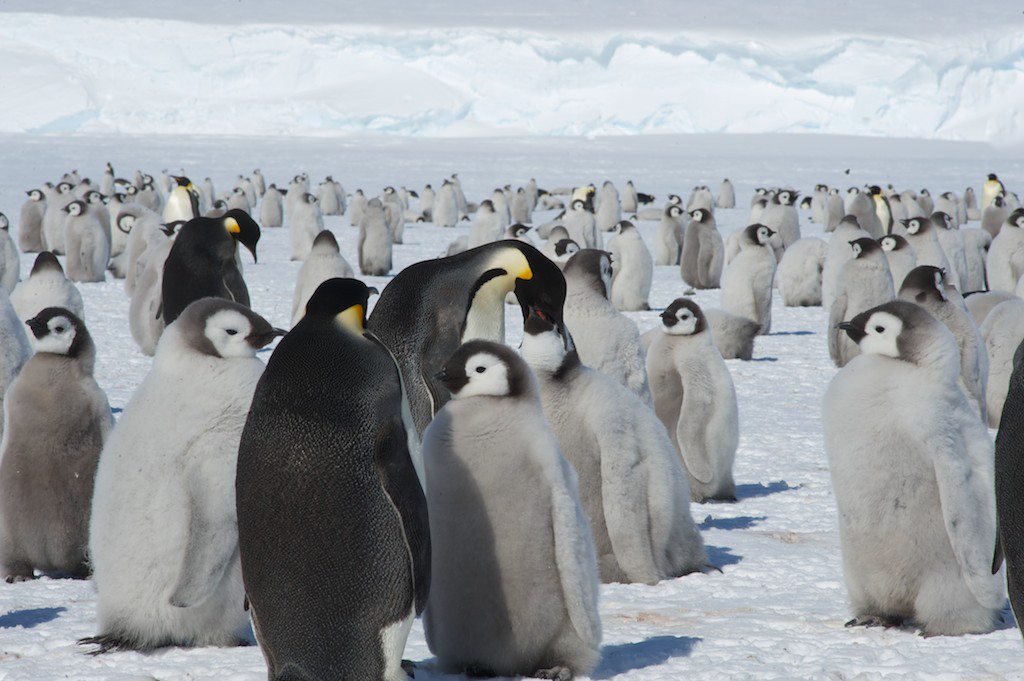
Babies Abound at Penguin Colony Found by Poop

A recent visit to a remote Antarctic emperor penguin colony found thousands of fuzzy penguin chicks, meaning the colony is even bigger than previously thought.
A team from Belgium's Princess Elisabeth Antarctica polar research station estimates there are 15,000 penguins living in four groups at the colony, on East Antarctica's Princess Ragnhild Coast. The team counted the number of chicks demanding regurgitated meals from their parents to gauge the total colony size, because the adults were off fishing for food.
"The [good] weather this season gave us the opportunity this season to spend a bit more of time counting individual emperor penguins," said Alain Hubert, the expedition leader and founder of the International Polar Foundation, which designed and built the research station. "What surprised me is that each group was 5 to 7 percent chicks. It means that it is a healthy rookery; this opinion can be reinforced by the fact that I didn't find more than five dead little chicks at the overwintering place," Hubert told LiveScience's OurAmazingPlanet in an email interview from Antarctica. [Charming Chicks: Antarctica's Baby Penguins]
A December 2012 expedition from Princess Elisabeth station marked the first time humans saw this colony of flightless birds. The colony was suspected to exist because their poop was spotted by satellites in 2009, leaving light brown trails on the ice.
Lots of chicks
This year's penguin count confirms the accuracy of the satellite monitoring, Hubert said. "We found a real rookery of about 15,000 individuals, and in a very good health, at a latitude of only south 70 degrees, a position which is critical for most of the colonies in West Antarctica," Hubert said. "This a good sign for the survival of the species."
The team found only about 100 adult penguins along the shoreline, where the ice meets the sea, compared with about 1,000 adults last year, Hubert said. "They might all be gone fishing," he said. Other birds sighted during the trip include Adelie penguins and skuas, a type of seabird that preys on penguin chicks.
Sign up for the Live Science daily newsletter now
Get the world’s most fascinating discoveries delivered straight to your inbox.
The baby penguins were further inland, slowly migrating toward stable sea ice, about 6 miles (10 kilometers) from their overwintering spot where the fathers huddle together for warmth and tend their eggs. After winter ends, parents make trips to the sea to deliver meals to their chicks.
Hubert and field guide Christophe Berclaz had to pick their way down a 130-foot-tall (40 meters) ice cliff to find the waddling groups of penguins.
Pesky penguins
Seeing the fuzzy penguin chicks demand a vomited-up meal was Hubert's favorite part of the few hours spent at the massive colony.
"They are so cute and funny, especially the chicks bothering the parents without interruption to try to get fed. I can't get tired of looking at them," he said.
Emperor penguins are the largest penguin species and stand on average about 45 inches (114 centimeters) tall and weigh 90 pounds (41 kilograms) when full-grown.
Satellite imagery has helped find previously unknown penguin colonies in Antarctica, expanding their known population, but the future of penguin species remains uncertain as global warming changes Antarctica's climate.
Email Becky Oskin or follow her @beckyoskin. Follow us OurAmazingPlanet @OAPlanet, Facebook and Google+. Original article at LiveScience's OurAmazingPlanet.











